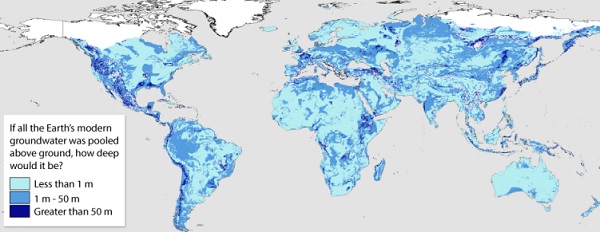Water Running Out? New Map Reveals Remaining Groundwater on Earth
| Ana Verayo | | Nov 17, 2015 06:20 AM EST |
(Photo : University of Victoria) This new map reveals the Earth's hidden groundwater.
A new map reveals how much groundwater is left hidden in the planet, as this new study also shows how less than six percent of groundwater that is located within two kilometers of the planet's upper crust will be replenished within a human lifetime.
Like Us on Facebook
According to lead author of the study, Tom Gleeson from the University of Victoria in Canada, this information was not known before as ground water has never been mapped until now. He adds that there are numerous aquifers where water reserves are dropping to dangerously low levels, which means that humans are using up ground water resources too fast, faster before they even get renewed again.
In this new study, hydrologists from all over the world utilized data and computer models that created the first data based estimate of the planet's total supply of ground water. Researchers revealed that there is an estimated volume of underground water equal to 23 billion cubic kilometers where 0.35 million cubic kilometers of water is just renewed, not older than 50 years old.
This underground water is found within the Earth's surface as it originates from rain, snowpacks, or water leaking from the bottom of river systems and lakes as well. This water's age can range from a few months fresh to more than a million years old. According to the United States Geological Survey, this water can be found as deep as nine kilometers into the Earth's crust.
Gleeson says that now, since we already know how much ground water is being used up and how much is left, scientists can give a clear estimate how much water we have left before all of it runs out. He adds that water that lies near the surface is getting renewed at a much faster rate as opposed to water found deep within the Earth although, this ground water is also more susceptible to contamination and global warming but can also alleviate extreme temperatures.
Gleeson explains that water that is found deeper in the Earth is commonly used for agricultural and industrial purposes however, it contains arsenic and uranium that contain more salt than saltwater. He also adds that the importance of ground water lies in becoming an effective buffer when it comes to climate extremes.
This new study provides new insight about the remaining ground water on the planet, and if this supply is properly managed, it can flow and enter rivers during drought which makes it a valuable and strategic resource when dealing with extreme impacts of climate change especially for water reserves.
New findings also reveal that the most abundant regions of ground water are found in tropical climates, where the largest water deposits are located in the Amazon Basin, Congo and Indonesia and western borders of North and South America. The regions with the least amount of ground water are the dry and arid ones such as Australia, the Gobi and Sahara deserts and central North America.
This new study is published in the journal Nature Geoscience.
TagsWater Running Out? New Map Reveals Remaining Groundwater on Earth, groundwater earth, new map groundwater earth, how much water is left on earth, water reserves, Water Supply, global warming, water shortage, map groundwater earth
©2015 Chinatopix All rights reserved. Do not reproduce without permission
EDITOR'S PICKS
-

Did the Trump administration just announce plans for a trade war with ‘hostile’ China and Russia?
-

US Senate passes Taiwan travel bill slammed by China
-

As Yan Sihong’s family grieves, here are other Chinese students who went missing abroad. Some have never been found
-

Beijing blasts Western critics who ‘smear China’ with the term sharp power
-

China Envoy Seeks to Defuse Tensions With U.S. as a Trade War Brews
-

Singapore's Deputy PM Provides Bitcoin Vote of Confidence Amid China's Blanket Bans
-

China warns investors over risks in overseas virtual currency trading
-

Chinese government most trustworthy: survey
-

Kashima Antlers On Course For Back-To-Back Titles
MOST POPULAR
LATEST NEWS
Zhou Yongkang: China's Former Security Chief Sentenced to Life in Prison

China's former Chief of the Ministry of Public Security, Zhou Yongkang, has been given a life sentence after he was found guilty of abusing his office, bribery and deliberately ... Full Article
TRENDING STORY

China Pork Prices Expected to Stabilize As The Supplies Recover

Elephone P9000 Smartphone is now on Sale on Amazon India

There's a Big Chance Cliffhangers Won't Still Be Resolved When Grey's Anatomy Season 13 Returns

Supreme Court Ruled on Samsung vs Apple Dispute for Patent Infringement

Microsoft Surface Pro 5 Rumors and Release Date: What is the Latest?










